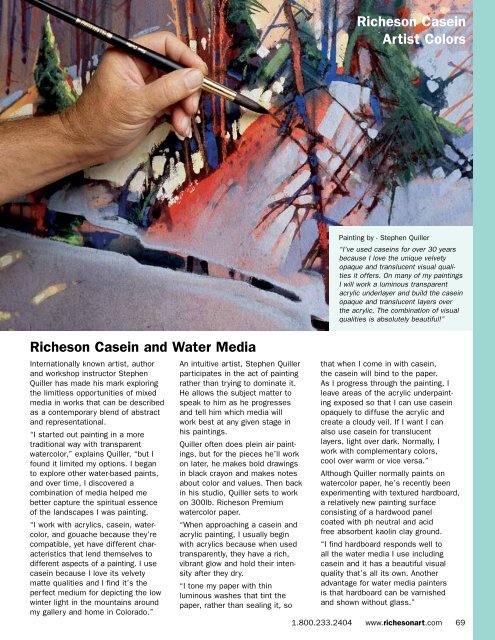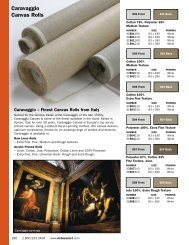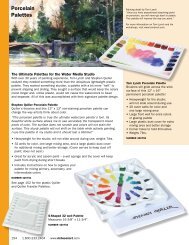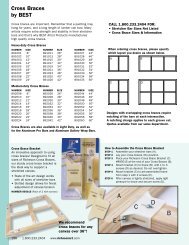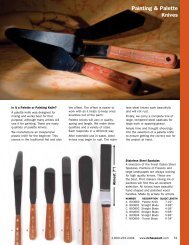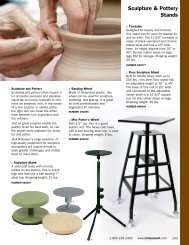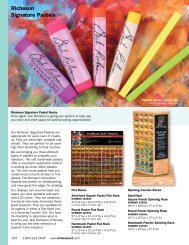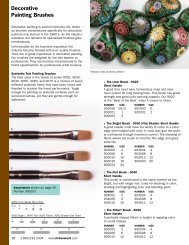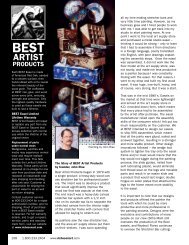Richeson Casein Artist Colors - Richeson Art
Richeson Casein Artist Colors - Richeson Art
Richeson Casein Artist Colors - Richeson Art
Create successful ePaper yourself
Turn your PDF publications into a flip-book with our unique Google optimized e-Paper software.
<strong>Richeson</strong> <strong>Casein</strong><br />
<strong><strong>Art</strong>ist</strong> <strong>Colors</strong><br />
Painting by - Stephen Quiller<br />
“I’ve used caseins for over 30 years<br />
because I love the unique velvety<br />
opaque and translucent visual qualities<br />
it offers. On many of my paintings<br />
I will work a luminous transparent<br />
acrylic underlayer and build the casein<br />
opaque and translucent layers over<br />
the acrylic. The combination of visual<br />
qualities is absolutely beautiful!”<br />
<strong>Richeson</strong> <strong>Casein</strong> and Water Media<br />
Internationally known artist, author<br />
and workshop instructor Stephen<br />
Quiller has made his mark exploring<br />
the limitless opportunities of mixed<br />
media in works that can be described<br />
as a contemporary blend of abstract<br />
and representational.<br />
“I started out painting in a more<br />
traditional way with transparent<br />
watercolor,” explains Quiller, “but I<br />
found it limited my options. I began<br />
to explore other water-based paints,<br />
and over time, I discovered a<br />
combination of media helped me<br />
better capture the spiritual essence<br />
of the landscapes I was painting.<br />
“I work with acrylics, casein, watercolor,<br />
and gouache because they’re<br />
compatible, yet have different characteristics<br />
that lend themselves to<br />
different aspects of a painting. I use<br />
casein because I love its velvety<br />
matte qualities and I find it’s the<br />
perfect medium for depicting the low<br />
winter light in the mountains around<br />
my gallery and home in Colorado.”<br />
An intuitive artist, Stephen Quiller<br />
participates in the act of painting<br />
rather than trying to dominate it.<br />
He allows the subject matter to<br />
speak to him as he progresses<br />
and tell him which media will<br />
work best at any given stage in<br />
his paintings.<br />
Quiller often does plein air paintings,<br />
but for the pieces he’ll work<br />
on later, he makes bold drawings<br />
in black crayon and makes notes<br />
about color and values. Then back<br />
in his studio, Quiller sets to work<br />
on 300lb. <strong>Richeson</strong> Premium<br />
watercolor paper.<br />
“When approaching a casein and<br />
acrylic painting, I usually begin<br />
with acrylics because when used<br />
transparently, they have a rich,<br />
vibrant glow and hold their intensity<br />
after they dry.<br />
“I tone my paper with thin<br />
luminous washes that tint the<br />
paper, rather than sealing it, so<br />
that when I come in with casein,<br />
the casein will bind to the paper.<br />
As I progress through the painting, I<br />
leave areas of the acrylic underpainting<br />
exposed so that I can use casein<br />
opaquely to diffuse the acrylic and<br />
create a cloudy veil. If I want I can<br />
also use casein for translucent<br />
layers, light over dark. Normally, I<br />
work with complementary colors,<br />
cool over warm or vice versa.”<br />
Although Quiller normally paints on<br />
watercolor paper, he’s recently been<br />
experimenting with textured hardboard,<br />
a relatively new painting surface<br />
consisting of a hardwood panel<br />
coated with ph neutral and acid<br />
free absorbent kaolin clay ground.<br />
“I find hardboard responds well to<br />
all the water media I use including<br />
casein and it has a beautiful visual<br />
quality that’s all its own. Another<br />
advantage for water media painters<br />
is that hardboard can be varnished<br />
and shown without glass.”<br />
1.800.233.2404 www.richesonart.com 69
<strong>Richeson</strong> <strong>Casein</strong> <strong><strong>Art</strong>ist</strong> <strong>Colors</strong><br />
Q: Can I paint on canvas with casein?<br />
A: <strong>Casein</strong> can be used on canvas,<br />
although only in very thin application.<br />
Since <strong>Casein</strong> in its cured state can<br />
be brittle, we recommend that artists<br />
paint on rigid surfaces. If you want the<br />
texture of paint on canvas, mounting<br />
the canvas on wood or panel is the best<br />
solution.<br />
Q: What other surfaces can I paint on<br />
using casein?<br />
A: Just about anything! <strong>Casein</strong> can be<br />
used on interior walls, metal, wood, laminates,<br />
metal, glass or ceramics. Clean<br />
the surface thoroughly and on walls,<br />
metal, wood or laminates, “prime” the<br />
surface with a couple layers of gesso<br />
or a PVA glue such as Weldbond (mix<br />
50/50 with water). For slick surfaces<br />
like glass, ceramics or metal, use denatured<br />
alcohol to thoroughly clean the<br />
surface. You can then prime the surface<br />
with a PVA & water solution as above.<br />
Q: What kind of watercolor paper<br />
is recommended for casein?<br />
A: Again, rigidity counts! You can paint<br />
on 140lb. watercolor paper if the painting<br />
will be properly framed shortly after<br />
completion. 300 lb. paper is a much<br />
better choice because of its stiffness<br />
– and properly varnished and cradled<br />
could even be framed without glass.<br />
Q: What should I use for a palette?<br />
A: Because casein will stain plastic palettes,<br />
a butcher tray, porcelain tray or<br />
a glass surface backed with a mid-tone<br />
gray paper provides an excellent mixing<br />
surface. Alternately, a disposable paper<br />
palette can be used for its convenience<br />
and ease of clean up.<br />
Q: Can I keep casein from drying<br />
on my palette?<br />
A: Keep a spray bottle of water handy<br />
and spritz the paint on your palette<br />
periodically. Covering your palette with<br />
plastic wrap (after spritzing) and putting<br />
it in your fridge overnight will keep it<br />
especially fresh. One can avoid the drying<br />
issues entirely by only squeezing out<br />
approximately as much paint as will be<br />
used at one time.<br />
Q: What grounds can I paint on?<br />
A: Rabbit skin glue, PVA glue and acrylic<br />
gesso. Just make sure there’s no oil on<br />
the grounds.<br />
Q: What kind of brushes work best<br />
with casein and what is the best way<br />
to clean them?<br />
A: <strong>Casein</strong>, like acrylic, can be rough on<br />
brushes if you don’t take good care of<br />
them! Its heavy consistency can also<br />
be an issue. Use bristle brushes or<br />
synthetic soft hair, but never use one<br />
made from sable! As with any painting<br />
medium, use the end of the brush head<br />
to pick up and apply paint: Paint getting<br />
into the ferrule of the brush can damage<br />
it! Keep your used brushes in a<br />
brush washer with the heads immersed<br />
in water until you clean them with water<br />
and dish soap. For especially stubborn<br />
colors, add a bit of ammonia to the<br />
soap before washing. Rinse very well,<br />
and be sure to “snap” your brush back<br />
to its original shape before setting it out<br />
to dry. Brush cleaners and conditioners<br />
also work well and are another way to<br />
keep your brushes usable for years to<br />
come.<br />
Q: How do I prepare a casein<br />
painting for hanging?<br />
A: You have several choices, depending<br />
on the painting surface you’ve chosen.<br />
If you’ve used paper, you should mount,<br />
matte and frame as you would a watercolor.<br />
If you’ve used a surface such as<br />
panel, wood, glass, etc., you can choose<br />
to let the casein cure for 2-3 weeks and<br />
then hand-buff with a clean, lint-free<br />
cotton cloth to bring up a satin sheen<br />
that will serve as the final surface of<br />
the painting. You may also choose to<br />
varnish a casein painting. Using a gloss<br />
varnish will produce a finish similar to<br />
that of an oil painting.<br />
Q: What about varnish?<br />
A. Varnish is a matter of preference.<br />
<strong>Richeson</strong> <strong>Casein</strong> Varnish or a gloss<br />
varnish intensifies the color. Using a<br />
matte acrylic varnish will preserve that<br />
“authentic casein” look. Wait until the<br />
surface has cured 2-3 weeks and no<br />
longer reconstitutes with water and then<br />
apply the varnish in the same manner<br />
as you would for an acrylic or oil painting<br />
(spray or airbrush application will<br />
help you avoid brush marks). If you<br />
don’t have time to wait, you can use a<br />
spray varnish (applied in light coats in<br />
a well-ventilated area) within a day of<br />
the painting being dry to the touch. The<br />
casein will continue to cure even when<br />
varnished in this manner. Be sure to<br />
follow the manufacturer’s safety recommendations<br />
when using varnish.<br />
Q: Are caseins archival?<br />
A. Yes, properly done and with a protective<br />
varnish, caseins can last longer<br />
than oils, especially oils on canvas.<br />
They also will not crack or yellow.<br />
Q: How should I apply caseins?<br />
A: You have a myriad of choices!<br />
You can apply casein “juicy” like watercolors,<br />
impasto like oils, or anything<br />
in between. A rigid surface, such as a<br />
canvas panel, is critical when applying<br />
casein thickly (to prevent cracking if the<br />
surface is flexed). You can use a painting<br />
knife, brushes, cloth or even your<br />
fingers to apply casein to your surface.<br />
Q: Are casein paints transparent?<br />
A: The degree of opacity varies from<br />
color to color, with white being opaque<br />
and affecting the opacity of other colors<br />
it’s mixed with. When you make your<br />
color chart, include a section for each<br />
color combination to be applied over a<br />
strip of a mid-tone gray. By doing this,<br />
you create an opacity reference.<br />
Q: Do casein colors mix like other<br />
paints?<br />
A: Yes! Wet casein does look about a<br />
shade darker than it will when it dries.<br />
Get to know the paint by making yourself<br />
a color-mixing chart (a good idea no<br />
matter what medium you are using!).<br />
Q: Can I mix casein with other<br />
mediums?<br />
A: Yes you can! Use casein over watercolor<br />
or gouache or as an underpainting<br />
for acrylic, pastel or oils. If using casein<br />
under oils, apply a barrier layer of<br />
Kamar or Damar varnish over the casein<br />
before the oil paint. <strong>Casein</strong> can also be<br />
used under oils as an underpainting.<br />
Q: What about glazes?<br />
A: There are three methods of glazing<br />
caseins, all of which are structured<br />
around the need to avoid inadvertently<br />
lifting a previously painted layer. First,<br />
and most obvious, is to wait a couple<br />
of weeks until the casein cures.<br />
Second is to wait until the casein is<br />
dry to the touch (just a few minutes<br />
and can be accelerated by using a hair<br />
dryer); prepare your glaze by adding a<br />
small amount of paint to water or to<br />
<strong>Casein</strong> Emulsion.<br />
70 1.800.233.2404 www.richesonart.com
<strong>Casein</strong> Color Studies & Underpainting<br />
A little goes a long way – just be aware<br />
that <strong>Casein</strong> Emulsion used “straight” in<br />
this manner will dry to a semi-gloss finish,<br />
not casein’s usual matte surface.<br />
Painting by - R. Tate<br />
For more information, visit<br />
www.rtatepainting.com.<br />
You can use acrylic flat varnish over<br />
this area later if you prefer or it will<br />
“even out” when you apply any finish<br />
varnish to the whole painting. When<br />
using this method, identify the area you<br />
want to glaze and using a light touch,<br />
carefully apply the glaze in one stroke<br />
only for each brush width of area.<br />
The final method is to use PVA<br />
glue such as Weldbond. Mix 1 part<br />
Weldbond to 3 parts water. This<br />
solution can be applied with a foam<br />
brush, but again, be sure to only apply<br />
the glaze in one pass over an area. If<br />
your painting is small enough, it may<br />
be easier to pour the solution over the<br />
painting rather than brush it on.<br />
Get a flat pan a bit larger than the<br />
painting. Hold the painting over the pan<br />
and pour on the water/glue solution.<br />
Tilt the painting to cover the entire<br />
surface with the solution. (Reclaim<br />
unused solution from the drip pan by<br />
storing it in an airtight container). Wait<br />
until the glue layer dries (accelerate<br />
with a hair dryer if desired) and apply<br />
your next paint glaze.<br />
Q: What is half-tone black?<br />
A: The pigment in half-tone black is<br />
more finely dispersed than in the<br />
other casein colors. Think of it as a<br />
separate, transparent color, not “pale<br />
black.” It is meant to be applied as a<br />
glaze. Use it on your color mixing chart<br />
to show the effects of half-tone black<br />
over other casein colors. For instance,<br />
half-tone black over burnt sienna<br />
results in a beautiful purple.<br />
Q. Why does the color chart show a<br />
95% color + 5% white wash?<br />
A. Adding a touch of white to your<br />
casein colors will help you control<br />
your washes. 5% white will make<br />
washes lighten gradually from opaque<br />
to transparent instead of changing too<br />
rapidly. Try it, you won’t believe the<br />
difference.<br />
<strong>Casein</strong> & Color Studies<br />
Although he had used casein in<br />
college, Robert Tanenbaum didn’t<br />
begin working with it seriously until the<br />
early 1970’s when a fellow illustrator<br />
recommended its use particularly<br />
for highlights. It was much easier to<br />
use casein instead of watercolor or<br />
gouache.<br />
With some experimentation,<br />
Tanenbaum found that casein was<br />
also perfect for tight details and textures,<br />
and that its quick drying properties<br />
made it ideal for preliminary color<br />
sketches and for underpainting.<br />
“Years ago, I learned that by doing<br />
small preliminary color sketches, I<br />
could work out the composition,<br />
colors and value patterns. I could spot<br />
problems early on, so that I could be<br />
more spontaneous with my final images,<br />
instead of laboring over them.<br />
“I think casein is the best choice for<br />
color sketches because it usually<br />
dries within a few minutes and I can<br />
make changes immediately or quickly<br />
move onto the next stage.”<br />
When doing his preliminary sketches,<br />
Tanenbaum creates a relatively<br />
detailed drawing of the figure. He then<br />
begins by laying in the casein, using<br />
the same techniques as he does with<br />
oil – applying painterly brush strokes,<br />
and blending and softening the edges<br />
before the casein dries entirely.<br />
<strong>Casein</strong> & Color Studies (con'd)<br />
When he gets his color sketch to a<br />
level he’s happy with, he’s ready to<br />
approach his final oil painting. Again,<br />
casein plays a major role.<br />
<strong>Casein</strong> & Underpainting<br />
“When I paint in oil, I still tone with<br />
casein because I can use oil as soon<br />
as the casein feels dry to the touch.<br />
If I tone with oil, I have to wait for a<br />
long time until it sets up. “For my oil<br />
paintings, I use a stretched canvas,<br />
which I re-gesso before I do a pencil<br />
drawing. The pencil takes the gessoed<br />
surface better and comes out black so<br />
I can see it through the underpainting.<br />
I spray the drawing with a workable<br />
fixative, which sets the drawing so<br />
that it won’t bleed into the paint or<br />
disappear.<br />
“Then I lay on an opaque casein<br />
passage to completely cover the white<br />
of the canvas, but I’m careful not to<br />
lay it so thickly that it becomes impasto.<br />
After that, I begin painting with oil.”<br />
As long as an artist doesn’t lay on<br />
casein too thickly, it’s an excellent<br />
choice for underpainting because it’s<br />
insoluble once it dries. The casein will<br />
easily accept the oil and will form a<br />
good mechanical bond,” explains Ross<br />
Merrill, Former Chief of Conservation<br />
for the National Gallery of <strong>Art</strong> in<br />
Washington D.C.<br />
“One thing an artist must never do<br />
is underpaint oils with acrylic paint,”<br />
says Merrill. “Acrylic paints are formulated<br />
with a ‘closed’’ surface to protect<br />
the paint from stains, grime and<br />
other pollutants. This ‘closed’ surface<br />
is non-absorbent and over time, the<br />
oil on top could actually de-laminate<br />
and come off in layers. Using acrylic<br />
gesso, however, works fine with casein<br />
or oil paint because it has an ‘open’<br />
surface to accept the paint layer and<br />
form a mechanical bond.”<br />
1.800.233.2404 www.richesonart.com 71
<strong>Richeson</strong> <strong>Casein</strong><br />
<strong><strong>Art</strong>ist</strong> <strong>Colors</strong><br />
<strong>Casein</strong> & Egg Tempera<br />
Doug Wiltraut, an experienced egg<br />
tempera painter, has discovered<br />
the beautiful qualities casein has<br />
to offer. While egg tempera is<br />
characterized by its pureness of<br />
color and luminosity, it also has<br />
some qualities that make it a bit<br />
difficult to work with.<br />
Painting by - Douglas Wiltraut<br />
Douglas Wiltraut, one of America's foremost painters in egg tempera and dry brush<br />
watercolor. Currently the President of the National Society of Painters in <strong>Casein</strong> &<br />
Acrylic, Inc., he has been the recipient of numerous national awards. He was the<br />
subject of a feature article on egg tempera painting in both American <strong><strong>Art</strong>ist</strong> and<br />
The <strong><strong>Art</strong>ist</strong>’s Magazine.<br />
For more information on Doug and his work, visit www.douglaswiltraut.com.<br />
First, egg tempera must be made<br />
from “scratch” by the artist, and<br />
because it is made from a perishable<br />
item, new paint needs to be made<br />
each day. This presents a challenge<br />
in matching colors. Second, egg tempera<br />
does not blend easily because<br />
it is such a fast-drying medium. It<br />
must be applied in numerous thin,<br />
semi-opaque and transparent layers.<br />
Many artists use a cross hatching<br />
technique with their brush strokes to<br />
create a clean, matte finish to their<br />
paintings, but the process is generally<br />
time-consuming.<br />
While egg tempera is a unique<br />
medium with a rich history, <strong>Richeson</strong><br />
<strong>Casein</strong> paints are able to achieve<br />
some of the beautiful qualities of<br />
egg tempera without some of its<br />
drawbacks.<br />
<strong>Richeson</strong> <strong>Casein</strong> paints are made<br />
according to high quality standards<br />
so you can be sure that every color<br />
is the same each time you paint with<br />
it. There are even color charts available<br />
for you to see the colors before<br />
you buy them.<br />
<strong>Richeson</strong> <strong>Casein</strong> paints are also very<br />
blendable. They can be applied in a<br />
tight, detailed manner, or be diluted<br />
with water to create a sweeping wash<br />
across the surface. While casein<br />
paints dry fairly quickly, they remain<br />
workable for some time even after<br />
they have dried.<br />
<strong>Richeson</strong> <strong>Casein</strong> paints can also be<br />
used with a variety of other mediums<br />
including egg tempera! Egg tempera<br />
artists now have a wonderful<br />
addition to their palette with<br />
<strong>Richeson</strong> <strong>Casein</strong> paints. By using<br />
the two together, some interesting<br />
effects can be achieved.<br />
72 1.800.233.2404 www.richesonart.com
<strong>Richeson</strong> <strong>Casein</strong><br />
<strong><strong>Art</strong>ist</strong> <strong>Colors</strong><br />
The Shiva Series<br />
What is <strong>Casein</strong>?<br />
<strong>Casein</strong> (kay'seen) is a quick-drying,<br />
aqueous medium using a milk-based<br />
binding agent, and is one of the<br />
most durable mediums known to<br />
man. Nine thousand year old casein<br />
cave paintings have been discovered<br />
in Asia, and later, the medium<br />
was used by Byzantine, Roman and<br />
Renaissance artists including the Old<br />
Masters.<br />
Detail of "A Walk in the Country" by John Molnar<br />
John Molnar (1960-2010)<br />
Born August 7, 1960, in Welland, Ontario, John Molnar<br />
died October 13, 2010 in Toronto of leukemia-related<br />
causes at age 50.<br />
At the celebration of John Molnar’s life, one of his art<br />
students recalled that John looked out on his class<br />
one day and said, “Isn’t it a miracle we’re all here?<br />
I mean, really." That pretty much sums up how John<br />
felt about his life, his students and his art.<br />
Although John had worked in commercial art, his<br />
real passion was fine art, which he began to pursue<br />
full-time in the late 1980s. Quickly becoming known for<br />
his lush landscape paintings in casein, John became<br />
the go-to person for expertise on the medium and<br />
answered questions from artists all over the world.<br />
John left a legacy of art that will keep his spirit alive<br />
forever. His death is a great loss to painters everywhere,<br />
especially in the medium of <strong>Casein</strong>.<br />
<strong>Richeson</strong> Paints are tested in<br />
accordance to: ASTM D-4236<br />
and bear safety labels to the<br />
standards issued by ACMI.<br />
While many Shiva ® colors are<br />
AP Approved non-toxic, certain<br />
colors do bear the CL label<br />
with safety warnings.<br />
Known for their versatility and array<br />
of capabilities, casein paints can be<br />
used to create a variety of effects<br />
from the rich opaques of oil to thin<br />
watercolor washes. Because casein<br />
has an exceptional integrity of color<br />
and always dries to a perfect matte<br />
finish, it is unexcelled for art<br />
reproduction. The velvety matte<br />
finish can also be buffed to a satin<br />
sheen or varnished to produce a<br />
resemblance to oils. Over time,<br />
casein pigments become resistant to<br />
moisture and as history has proven,<br />
the medium has a durability and<br />
permanence which has easily stood<br />
the test of time.<br />
<strong>Casein</strong> differs from other media, yet<br />
it shares many of the same characteristics,<br />
which make it a very versatile<br />
medium that lends itself to many<br />
techniques. <strong>Casein</strong> has the wash<br />
capabilities of watercolor, the smooth<br />
opacity of tempera and gouache,<br />
and the richer textures of oils and<br />
acrylics. Brushes dipped in casein<br />
keep their finesse, producing clear,<br />
crisp lines. Unlike oils, casein is a<br />
clean, water-soluble medium<br />
requiring no strong solvents.<br />
And because it dries quickly, it’s<br />
possible to lay on a glaze and move<br />
onto the next stage within a few<br />
hours instead of waiting for days,<br />
or even months, for oil glazes<br />
over oil to dry. In comparison to<br />
watercolors, the main advantage of<br />
casein is that it’s easily correctable.<br />
It can be removed with a cloth,<br />
brush or eraser.<br />
1.800.233.2404 www.richesonart.com 73
<strong>Richeson</strong> <strong>Casein</strong> <strong><strong>Art</strong>ist</strong> <strong>Colors</strong><br />
The Shiva Series<br />
Shiva® <strong>Casein</strong> <strong>Colors</strong> – 32 colors available in open stock and sets<br />
Titanium White Ivory Black Halftone Black Payne’s Grey Light Red Alizarin Crimson Venetian Red<br />
120500 I 120501 I 120502 I 120503 I 120504 I 120505 III 120506 I<br />
Rose Red Cadmium Red Deep Cadmium Red Pale Cadmium Red Scarlet Shiva Rose Yellow Ochre Cadmium Yellow Lt<br />
120507 I 120508 I 120509 I 120510 I 120511 III 120512 I 120513 I<br />
Cadmium Yellow Med Naples Yellow Cadmium Orange Cerulean Blue Cobalt Blue Ultramarine Blue Shiva Blue (Phthalo)<br />
120514 I 120515 II 120516 I 120517 I 120518 I 120519 I 120520 I<br />
Permasol Blue Shiva Violet Terra Verte Cadmium Green Shiva Green (Phthalo) Chrom. Oxide Green Burnt Sienna<br />
120521 I 120522 II 120523 I 120524 I 120525 I 120526 I 120527 I<br />
Key:<br />
Burnt Umber Raw Sienna Raw Umber Golden Ochre<br />
120528 I 120529 I 120530 I 120531 I<br />
Lightfastness:<br />
Excellent I Very Good II Fair III<br />
100% color<br />
50% color;<br />
50% white<br />
95% color; 5% white<br />
(white helps to achieve<br />
a luminous watercolor<br />
wash effect)<br />
<strong>Casein</strong> 1.25oz.<br />
120500 Titanium White<br />
120501 Ivory Black<br />
120502 Half Tone Black<br />
120503 Payne’s Grey<br />
120504 Light Red<br />
120505 Alizarin Crimson<br />
120506 Venetian Red<br />
120507 Rose Red<br />
120508 Cadmium Red Deep<br />
120509 Cadmium Red Pale<br />
120510 Cadmium Red Scarlet<br />
120511 Shiva Rose<br />
120512 Yellow Ochre<br />
120513 Cadmium Yellow Light<br />
120514 Cadmium Yellow Medium<br />
120515 Naples Yellow<br />
120516 Cadmium Orange<br />
120517 Cerulean Blue<br />
120518 Cobalt Blue<br />
120519 Ultramarine Blue<br />
120520 Shiva Blue (Phthalo)<br />
120521 Permasol Blue<br />
120522 Shiva Violet<br />
120523 Terra Verte<br />
120524 Cadmium Green<br />
120525 Shiva Green (Phthalo)<br />
120526 Chromium Oxide Green<br />
120527 Burnt Sienna<br />
120528 Burnt Umber<br />
120529 Raw Sienna<br />
120530 Raw Umber<br />
120531 Golden Ochre<br />
<strong>Casein</strong> 5oz.<br />
120532 Titanium White<br />
74 1.800.233.2404 www.richesonart.com<br />
Dealer Note: 1.25oz. tubes must be<br />
purchased in boxes of 3.
Painting detail by Julie Jilek<br />
www.juliejilek.com<br />
<strong>Richeson</strong> <strong>Casein</strong><br />
<strong><strong>Art</strong>ist</strong> Color Sets<br />
The Shiva Series<br />
A<br />
C<br />
D<br />
B<br />
B<br />
E<br />
A. Basic <strong>Casein</strong> Set of 6<br />
Set includes 1.25oz. tubes of:<br />
titanium white, ivory black, rose red,<br />
naples yellow, ultramarine blue, and<br />
Shiva green (phthalo).<br />
Number 120533<br />
B. Wooden Box Set of 12<br />
This set contains 1.25oz tubes which<br />
are presented in a wooden slide-top<br />
box. Includes: titanium white, ivory<br />
black, rose red, light red, naples<br />
yellow, yellow ochre, Shiva green,<br />
ultramarine blue, Shiva blue,<br />
Shiva violet, burnt sienna and<br />
golden ochre.<br />
Number 120541<br />
C. Wooden Box Set of 6<br />
Contains the same colors as above,<br />
but this assortment comes packaged<br />
in an elegant, slide-top wooden box.<br />
Number 120542<br />
Helpful Tips for <strong>Casein</strong>s<br />
• Choose a rigid, non-oily surface for work<br />
• Establish correct drawing and value<br />
patterns with a thin underpainting<br />
• Dilute caseins with water to make<br />
washes & transparent glazes<br />
• <strong>Casein</strong> colors, especially reds, oranges,<br />
and yellows, tend to shift after drying<br />
• Lighten colors by adding more water<br />
or brighten them by adding powdered<br />
pigment<br />
• To correct an overly dark area, cover it<br />
with a more opaque layer of a lighter<br />
color<br />
• When working on a gessoed panel,<br />
correct any errors with an eraser or a<br />
1:9 ammonia and water mixture<br />
For more tips and complete information<br />
on casein, including a variety of usage<br />
instructions, see our printed Paint Color<br />
Chart.<br />
Number L20004<br />
D. <strong>Casein</strong> Color Theory Set of 6<br />
Perfect for color theory, casein has<br />
little color shift, mixes easily!<br />
Set includes 1.25oz. tubes of:<br />
shiva rose, cadmium yellow light,<br />
ultramarine blue deep, cadmium<br />
orange, shiva green (phthalo), shiva<br />
violet.<br />
Number 120550<br />
E. <strong>Casein</strong> Underpainting Set of 6<br />
Watermedia and oil underpainting<br />
material now a basic warm and cool<br />
color set for every painter!<br />
Set includes 1.25oz. tubes of:<br />
burnt sienna, raw umber, paynes<br />
grey, yellow ochre, cadmium red pale,<br />
permasol blue.<br />
Number 120560<br />
1.800.233.2404 www.richesonart.com 75
<strong>Richeson</strong> <strong>Casein</strong> Assortments<br />
The Shiva Series<br />
A. <strong>Richeson</strong> CASEIN<br />
Full AssoRTment<br />
Number 120537<br />
1.25 Oz<br />
6 - 120500 Titan White<br />
6 - 120501 Ivory Black<br />
3 - 120502 Shva Blck<br />
3 - 120503 Paynes Grey<br />
3 - 120504 Light Red<br />
3 - 120505 Aliz Crimson<br />
3 - 120506 Venetian Rd<br />
3 - 120507 Rose Red<br />
3 - 120508 Cad Red Dp<br />
3 - 120509 Cad Red Pale<br />
3 - 120510 Cad Red Scrlt<br />
3 - 120511 Shiva Rose<br />
3 - 120512 Yellow Ochre<br />
3 - 120513 Cad Ylw Lt<br />
3 - 120514 Cad Ylw Med<br />
3 - 120515 Naples Ylw Hue<br />
3 - 120516 Cad Orange<br />
3 - 120517 Cerelean Blue<br />
3 - 120518 Cobalt Blue<br />
3 - 120519 Ultrmrine Bl Dp<br />
3 - 120520 Shiva Blu (Phthalo)<br />
3 - 120521 Permasol Blue<br />
3 - 120522 Shiva Violet<br />
3 - 120523 Terre Verte<br />
3 - 120524 Cadmium Green<br />
3 - 120525 Shiva Grn (Phthalo)<br />
3 - 120526 Chrom Ox Grn<br />
3 - 120527 Burnt Sienna<br />
3 - 120528 Burnt Umber<br />
3 - 120529 Raw Sienna<br />
3 - 120530 Raw Umber<br />
3 - 120531 Gold Ochre<br />
3 - 120532 Ttnm Wht 5oz<br />
3 - 120730 <strong>Casein</strong> Emulsion<br />
3.75 oz<br />
3 - 120732 <strong>Casein</strong> Varnish<br />
3.75 oz<br />
B. <strong>Richeson</strong> CASEIN<br />
Narrow AssoRTment<br />
Number 120538<br />
1.25 Oz<br />
12 - 120500 Titan White<br />
12 - 120501 Ivory Black<br />
6 - 120502 Shva Blck<br />
6 - 120503 Paynes Grey<br />
6 - 120504 Light Red<br />
6 - 120505 Aliz Crimson<br />
6 - 120506 Venetian Rd<br />
6 - 120507 Rose Red<br />
6 - 120508 Cad Red Dp<br />
6 - 120509 Cad Red Pale<br />
6 - 120510 Cad Red Scrlt<br />
6 - 120511 Shiva Rose<br />
6 - 120512 Yellow Ochre<br />
12 - 120513 Cad Ylw Lt<br />
6 - 120514 Cad Ylw Med<br />
6 - 120515 Naples Ylw Hue<br />
6 - 120516 Cad Orange<br />
6 - 120517 Cerelean Blue<br />
6 - 120518 Cobalt Blue<br />
12 - 120519 Ultrmrine Bl Dp<br />
6 - 120520 Shiva Blu (Phthalo)<br />
6 - 120521 Permasol Blue<br />
6 - 120522 Shiva Violet<br />
6 - 120523 Terre Verte<br />
6 - 120524 Cadmium Green<br />
6 - 120525 Shiva Grn (Phthalo)<br />
6 - 120526 Chrom Ox Grn<br />
6 - 120527 Burnt Sienna<br />
6 - 120528 Burnt Umber<br />
6 - 120529 Raw Sienna<br />
6 - 120530 Raw Umber<br />
6 - 120531 Gold Ochre<br />
6 - 120533 Basic 6/1.25oz<br />
2 - 120730 <strong>Casein</strong> Emulsion<br />
3.75 oz<br />
2 - 120732 <strong>Casein</strong> Varnish<br />
3.75 oz<br />
All assortments include a FREE rack if requested with order.<br />
Call Customer Service at 1.800.233.2404 for specific contents of our racks.<br />
Filled Rack for <strong>Richeson</strong> <strong>Casein</strong><br />
Includes 3 – 1.25oz. tubes of an<br />
assortment (6 black/6 white) of 30<br />
different colors (popular colors -<br />
duplicates),<br />
3 – 5oz. tubes of Titanium White and<br />
3 – 3.75oz. jars of mediums: <strong>Casein</strong><br />
Emulsion and <strong>Casein</strong> Varnish.<br />
Number 120537<br />
Empty Rack for <strong>Richeson</strong> <strong>Casein</strong>s<br />
Dimensions are 25-1⁄2" x 24-1⁄4" x<br />
5-1⁄2". Header measures 6-1⁄2" tall<br />
and 23" wide.<br />
Number 120536<br />
76 1.800.233.2404 www.richesonart.com<br />
<strong>Richeson</strong> <strong>Casein</strong> Narrow Rack<br />
This oak rack contains 6 each of 32<br />
colors, plus duplicates of the most<br />
popular colors for a total of 216<br />
tubes! It also includes 2 each of the<br />
following: Basic Sets of 6, <strong>Casein</strong><br />
Emulsion and <strong>Casein</strong> Varnish. Rack<br />
and header are included free with<br />
assortment if requested with order.<br />
Display measures 15-3⁄4" wide by<br />
44-1⁄8" high by 7-5⁄8" deep.<br />
Additional 7-1⁄2" in height<br />
with header.<br />
Number 120538<br />
<strong>Richeson</strong> <strong>Casein</strong> Narrow Rack<br />
Empty<br />
Number 120539<br />
Empty Paint Tubes<br />
Sold in packs of 144.<br />
Number Description<br />
120534 1.25oz. tube<br />
120535 5oz. tube


